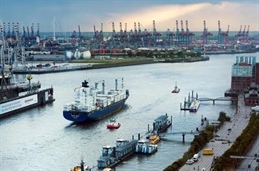
Port of Hamburg reported stable growth and regained market share compared to the two major western ports in the first half of 2025 despite continued subdued economic development and a tense geopolitical situation.
It said that strong growth in the container segment in the first half of 2025 contributed significantly to a solid increase in seaborne cargo throughput. Throughput of bulk goods and conventional general cargo decreased slightly.
Moreover, new liner services strengthened Hamburg's role in international sea freight transport as container hinterland connections continued their positive development, while transhipment traffic recorded a "very strong" half-year result.
Container throughput drives growth
Port of Hamburg said seaborne cargo throughput grew to 57.8 million tonnes in the months from January to June 2025 (+3.6% year-on-year), largely due to strong growth of 9.3% in container throughput to 4.2 million standard containers (TEU).
Double-digit growth of 11.6% was also recorded for imports, while container throughput for exports increased by 6.9%. On a per-tonne basis, it noted that containerised general cargo throughput grew to 41.2 million tonnes (+6.8%).
"We are delighted that the Port of Hamburg is able to benefit to this extent from new liner services and the restructuring of the shipping companies. In comparison with competing ports, Hamburg is thus able to set an extremely positive example and gain market share," Axel Mattern, CEO of Port of Hamburg Marketing, said.
Conventional general cargo throughput and bulk cargo throughput (-3.7% to 0.6 million tonnes and -3.8% to 16.0 million tonnes respectively) fell slightly in the first six months of the current year.
Port of Hamburg noted that markets in Asia and teh Baltic Sea region showed positive trends.
It said that the growth in container throughput was primarily generated by the Far East (+10.7% year-on-year to 1.8 million TEU) and Baltic Sea (+20.8% to 734,000 TEU) trade lanes.
In Asia, Malaysia (+93.2% to 169,000 TEU), which benefited from changes in transhipment routes, India (+41.6% to 137,000 TEU) and China (+10.5% to 1.2 million TEU) proved to be strong growth markets for throughput in the Port of Hamburg.
Among the Port of Hamburg's most important partner countries, only the US recorded a decline (-19.3% to 275,000 TEU), which can also be attributed to the upheavals caused by the US administration's trade policy.
More ship calls – in particular, large container ships
Compared to the same period last year, a total of 0.7% more ships with capacity for container cargo called at the Port of Hamburg.
The number of calls by large container ships with capacity for more than 10,000 TEU rose sharply again across all size classes (+51.6% to 285). Calls by ship units with capacities exceeding 24,000 TEU also recorded significant growth once again compared to the first half of 2024 (+29.6% to 127).
New liner services linking the Port of Hamburg with the Mediterranean, Middle East, Far East and India trade lanes had a positive impact. In addition, the container carriers have adapted better to rerouting around the Cape of Good Hope, such that the number of ship calls has stabilised.
Port of Haburg said the growth in throughput also had a positive impact on the the port's container hinterland transport, which increased by 2.2% year-on-year to 2.6 million TEU.
Transhipment throughput grew even more strongly. It amounted to 1.6 million TEU in the first half of 2025, which corresponds to growth of 23.8%.
"With renewed growth in container hinterland transport, the Port of Hamburg is maintaining a long-term trend. It will once again live up to its role as a hub between the markets in the Far East and Northern Europe, particularly the Baltic Sea region," Friedrich Stuhrmann, CCO at the Hamburg Port Authority, said.
"The greater combined ship widths in the passing box off Wedel, which have been tested since April, now allow for a more flexible organisation of traffic."
"With the transformation of the Waltershofer Hafen and the associated expansion of the turning circle now underway, we are launching pioneering projects and sending important signals to ensure that these developments continue in the future," he added.



